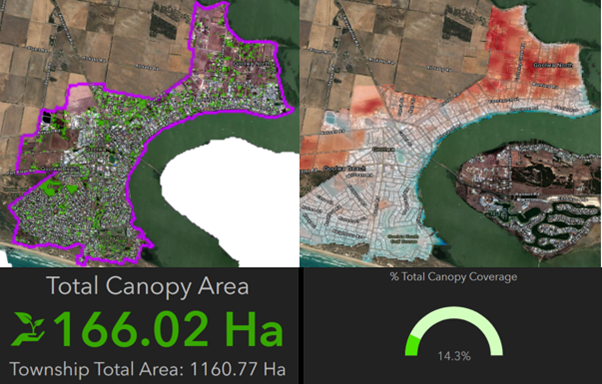Tree canopy coverage and heat maps – Goolwa
The canopy cover and radiant temperature visualisation maps for Goolwa are shown below:
 Aerial imagery showing Goolwa’s canopy coverage on the left, and the heat map of the township (radiant temperature visualisation) on the right. Data was captured on 26 January 2022. © Active Green Services
Aerial imagery showing Goolwa’s canopy coverage on the left, and the heat map of the township (radiant temperature visualisation) on the right. Data was captured on 26 January 2022. © Active Green Services
In 2022, Council commissioned a study to establish a benchmark of tree canopy cover and radiant temperature visualisation (‘heat maps’) across 11 townships in Alexandrina. The study assessed high-resolution satellite imagery using artificial intelligence. Thermal imaging (infrared) was also acquired and correlated to the canopy layer by linking the data geospatially via an ESRI© application.
The overall canopy cover averaged 17.6% across Alexandrina’s 11 townships; ranging from 11.7% to 49.3%.
The study showed that in January 2022, Goolwa had a tree canopy cover of 14.3%.
The results for Goolwa are as follows:
Tree canopy cover across Goolwa
The township total area of Goolwa is 1160.77 hectares (ha), with 166.02ha identified as the total canopy area. This equates to 14.3% total canopy coverage in Goolwa.
Tree canopy cover on private land
Most of the land in Goolwa is privately owned: 852.01ha of the township total area is private land, with 116.37ha of this contributing to the total canopy area. This means that 70.09% of the total canopy cover is found on private land.
Tree canopy cover on Council land
28.42% of the total canopy cover is on Council land: 293.97ha of the township total area is under Council’s care and control, with 47.19 ha contributing to the total canopy area.
Tree canopy cover on Crown land
A very small percentage of land is Crown land: 14.80ha of the township total area is on Crown land, with 2.46ha of this contributing to the total canopy area. This equates to 1.48% total canopy coverage in Goolwa.
Radiant temperature of Goolwa
The radiant temperature visualisation (‘heat map’) undertaken for Goolwa (see above) clearly shows the cooling effect that tree canopies and open water bodies provide.
The hottest areas are found in paddocks as relative radiant temperature of open parks and fields can be high compared to treed areas.
It is important to note is that radiant temperatures are not air temperatures. Satellite sensing is typically done at night. Radiant heat is measured as infrared spectral intensity and expressed as temperature mathematically, through prior research using controlled experiments correlating the influence of surface temperatures on perception of heat by a collective of people.
To go back to the main page of the Tree Canopy Report and links to other townships, click here.
